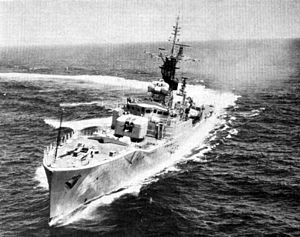HMS Torquay (F43)
This article needs additional citations for verification. (March 2013) |

| |
| History | |
|---|---|
| Name | HMS Torquay |
| Ordered | 6 March 1951 |
| Builder | Harland and Wolff |
| Laid down | 11 March 1953 |
| Launched | 1 July 1954 |
| Commissioned | 10 May 1956 |
| Decommissioned | 23 March 1985 |
| Identification | Pennant number: F43 |
| Fate | Scrapped 1987 |
| General characteristics | |
| Class and type | Whitby-class frigate |
| Displacement | |
| Length |
|
| Beam | 41 ft (12.5 m) |
| Draught | 17 ft (5.18 m) |
| Propulsion | Y-100 plant; 2 Babcock & Wilcox boilers, 2 English Electric steam turbines, 2 shafts, 30,000 shp (22 MW) |
| Speed | 30 kn (56 km/h) |
| Range | 370 tons oil fuel, 4,200 nmi (7,780 km) at 12 knots (22 km/h) |
| Complement | 152, later 225 |
| Sensors and processing systems |
|
| Armament |
|
HMS Torquay was a Type 12 Whitby-class frigate of the British Royal Navy. They were the first frigates to have the "V" form hull. This evolutionary design made it possible to be driven in head sea without the usual slamming which occurs with conventional destroyers of the time. Each frigate cost 3.5 million pounds and the first ship completed was Torquay in May 1956.
Design
The Whitbys were designed as specialist anti-submarine warships, intended to counter fast modern diesel-electric submarines. As such, the design was required to reach a speed of at least 27 knots (31 mph; 50 km/h), maintaining high speed in rough weather conditions and have a range of 4,500 nautical miles (5,200 mi; 8,300 km) at 12 knots (14 mph; 22 km/h). To meet these requirements, the Type 12s had a new hull form and, unlike the contemporary Type 41 anti-aircraft and Type 61 air direction frigates, were powered by steam turbines.[1][2]
Torquay was 370 feet 0 inches (112.78 m)
A twin
The ship was fitted with a
Operational Service
Torquay was laid down at Harland & Wolff's Belfast shipyard on 11 March 1953.[10] The ship was launched by Lady Monkton[citation needed] on 1 July 1954, and completed on 10 May 1956.[10]
On commissioning Torquay joined the 5th Frigate Squadron based at
Between 1963 and 1971 Torquay was one of the frigates allocated to the
Replaced by the Leander-class frigate Juno as the navigation training vessel for the Royal Navy, Torquay paid off on 23 March 1985. At the time she was the longest serving ship of her class and the oldest frigate in the fleet. She was sold for scrap in 1987 and left Portsmouth on 1 July 1987 to be broken up in Barcelona, Spain.
Notable individuals who commanded Torquay at some point in her history include Peter Berger, Fabian Malbon and John McAnally.
References
- ^ Friedman 2008, pp. 206–208
- ^ Gardiner & Chumbley 1995, pp. 514–515
- ^ Friedman 2008, pp. 321–322
- ^ Friedman 2008, pp. 157, 206, 208, 322
- ^ Marriott 1983, pp. 58, 64
- ^ Blackman 1960, p. 64
- ^ Friedman 2008, pp. 208, 322
- ^ a b c Marriott 1983, p. 55
- ^ Gardiner & Chumbley 1995, pp. 484, 519
- ^ a b Friedman 2008, p. 337
- ^ a b Critchley 1992, p. 96
- ^ a b "H.M.S. Torquay: Whitby Class Frigate Goes into Operational Service". Navy News. August 1956. p. 9. Retrieved 14 September 2018.
- ^ Roberts 2009, p. 21
- ^ Official Souvenir Programme, 1977. Silver Jubilee Fleet Review, HMSO
Sources
- Blackman, Raymond V. B. (1960). Jane's Fighting Ships 1960–61. London: Sampson Low, Marston & Co. Ltd.
- ISBN 978-1-86176-281-8.
- Critchley, Mike (1992). British Warships Since 1945: Part 5: Frigates. Liskeard, UK: Maritime Press. ISBN 0-907771-13-0.
- Friedman, Norman (2008). British Destroyers & Frigates: The Second World War and After. Barnsley, UK: Seaforth Publishing. ISBN 978-1-84832-015-4.
- Gardiner, Robert; Chumbley, Stephen, eds. (1995). Conway's All The World's Fighting Ships 1947–1995. Annapolis, Maryland, USA: Naval Institute Press. ISBN 1-55750-132-7.
- Marriott, Leo (1983). Royal Navy Frigates 1945–1983. Shepperton, Surrey, UK: Ian Allan Ltd. ISBN 0-7110-1322-5.
- Roberts, John (2009). Safeguarding the Nation: The Story of the Royal Navy. Barnsley, UK: Seaforth Publishing. ISBN 978-1-84832-043-7.
External links
| External images | |
|---|---|
